Après des années de création de sites WordPress, nous avons appris à quel point il est important d’avoir une installation locale de WordPress sur votre ordinateur.
Avoir WordPress sur votre machine personnelle vous permet d’expérimenter de nouvelles fonctionnalités sans risquer votre site en direct, de plonger profondément dans le développement de WordPress, et même de construire des sites entiers avant qu’ils ne soient mis en direct. C’est comme si vous aviez un bac à sable privé pour tous vos projets WordPress.
Si vous êtes un utilisateur de Windows, il existe de nombreuses façons d’installer WordPress localement. Mais nous avons réduit la liste aux deux méthodes les plus simples. Dans ce guide, nous vous montrerons comment installer facilement WordPress sur un ordinateur Windows, quelle que soit la version que vous utilisez.
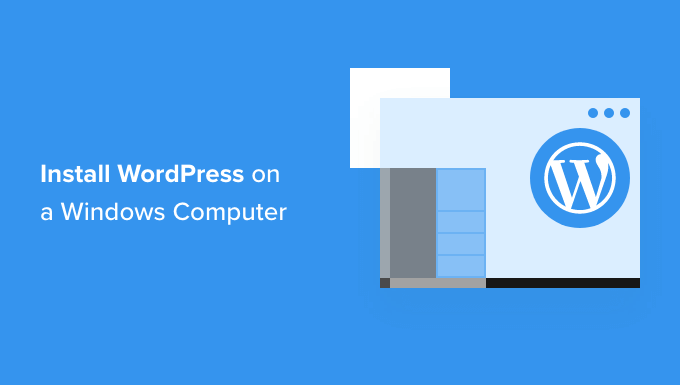
Pourquoi installer WordPress sous Windows ?
Si vous utilisez Windows, l’installation locale de WordPress sur votre ordinateur présente plusieurs avantages.
Une installation locale de WordPress crée un environnement de test qui n’affecte pas votre site direct. Cette installation, souvent appelée serveur local, est votre terrain de jeu personnel pour WordPress.
Les développeurs WordPress utilisent régulièrement des installations locales pour leur travail. Par exemple, ils peuvent s’en servir pour expérimenter de nouvelles extensions ou de nouveaux thèmes, ou pour tester le site avant la mise à jour vers l’éditeur de blocs Gutenberg.
Mais ce n’est pas seulement pour les professionnels. Si vous êtes nouveau sur WordPress, une installation locale est parfaite pour apprendre. Vous pouvez explorer les fonctionnalités, tester les thèmes et les extensions, et expérimenter librement sans craindre de casser un site en direct.
Il est important de noter que lorsque vous installez WordPress localement sous Windows, vous êtes le seul à pouvoir voir le site. Si vous souhaitez créer un site public, vous aurez besoin d’un nom de domaine et d’un hébergement.
Techniquement, il est possible d’installer WordPress sur Windows en utilisant XAMPP, et nous avons déjà écrit un tutoriel à ce sujet.
Cela dit, nous avons trouvé deux méthodes encore plus simples que XAMPP pour mettre en place un environnement WordPress local, ce qui les rend parfaites pour les débutants ou les utilisateurs qui ont besoin de créer un site local rapidement. Vous pouvez cliquer sur le lien ci-dessous pour passer à la méthode qui vous intéresse :
Méthode 1 : Installer WordPress sur Windows à l’aide de Studio (rapide et simple)
Pour la première méthode, nous utiliserons Studio. Il s’agit d’un logiciel WordPress local conçu par Automattic, la société qui gère et exploite WordPress.com, qui est un constructeur de sites web basé sur le logiciel WordPress.
Nous parlerons d’abord de cette méthode parce qu’elle est beaucoup plus rapide et plus simple à suivre, ce qui la rend idéale pour les débutants complets.
Tout d’abord, vous devez ouvrir le site Studio by WordPress.com. Ensuite, cliquez sur le bouton “Télécharger pour Windows”.

Une fois cela fait, il suffit d’ouvrir le fichier téléchargé pour lancer l’installation.
Une fenêtre contextuelle apparaît alors, vous indiquant que l’application est en cours d’installation.
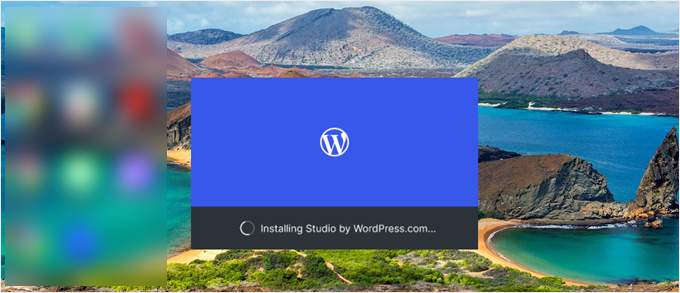
Ceci fait, vous pouvez ajouter votre premier site.
Pour ce faire, il vous suffit de saisir le nom de votre nouveau site WordPress local et de cliquer sur “Ajouter un site”. Vous pouvez nommer le site comme vous le souhaitez, tant qu’il vous permet de l’identifier facilement.
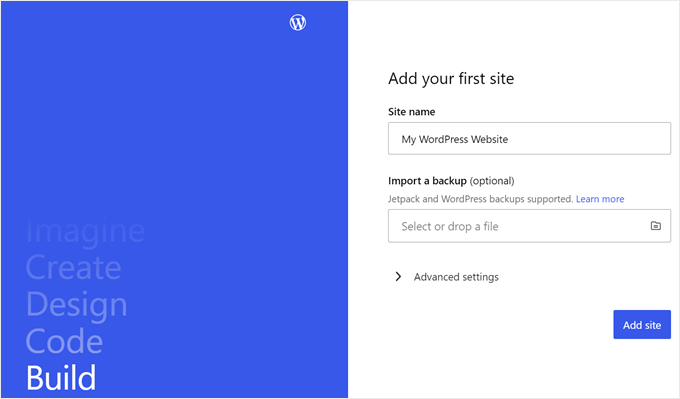
Vous devriez maintenant voir le tableau de bord de votre site WordPress local.
Pour accéder à votre tableau de bord WordPress et modifier votre site, il vous suffit de cliquer sur le bouton ” Démarrer ” en haut à droite. Vous pourrez ainsi accéder à votre site local sur votre ordinateur.
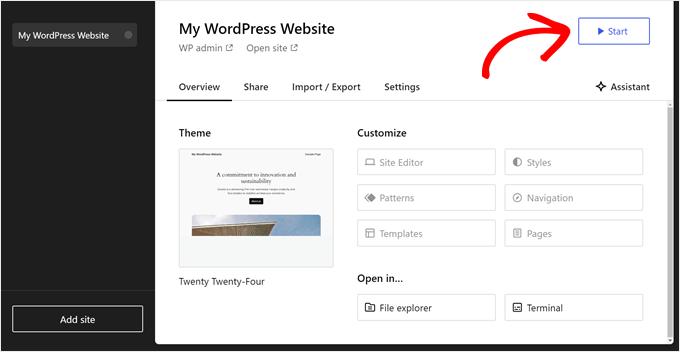
Une fois que le bouton “Start” est modifié en “Running”, vous pouvez cliquer sur le lien “WP Admin” en haut à gauche de la page.
Cela vous amènera à la page d’administration locale de WordPress.

Et c’est à peu près tout pour la configuration. Explorons les autres paramètres qui peuvent s’avérer nécessaires au fur et à mesure que vous construisez votre site local.
Comme vous pouvez le voir dans l’onglet ‘Overview’, vous pouvez immédiatement accéder au menu de l ‘éditeur WordPress full-site directement depuis le tableau de bord de Studio. Vous pouvez également cliquer sur ‘File explorer’ pour ouvrir les dossiers et les fichiers de votre site WordPress et cliquer sur ‘Terminal’ pour gérer votre site à l’aide de WP-CLI.
Si vous passez à l’onglet “Partager”, vous pouvez vous connecter à votre compte WordPress.com, cloner votre site local et le téléverser sur les serveurs de WordPress.com. Cela rendra temporairement le site cloné en ligne, ce qui est utile pour partager des sites de démonstration avec vos clients ou les membres de votre équipe.
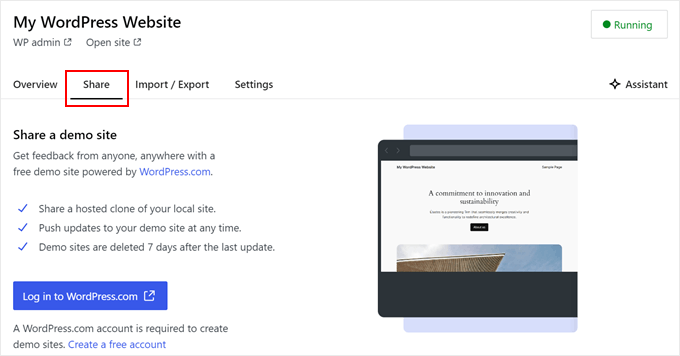
Il peut arriver que vous souhaitiez vous connecter à votre site local directement via votre navigateur au lieu d’utiliser Studio. Dans ce cas, vous devez connaître vos identifiants wp-admin.
Pour les trouver, vous pouvez passer à l’onglet “Réglages” et y trouver votre nom d’utilisateur, votre mot de passe et votre URL de connexion pour l’administration de WordPress.
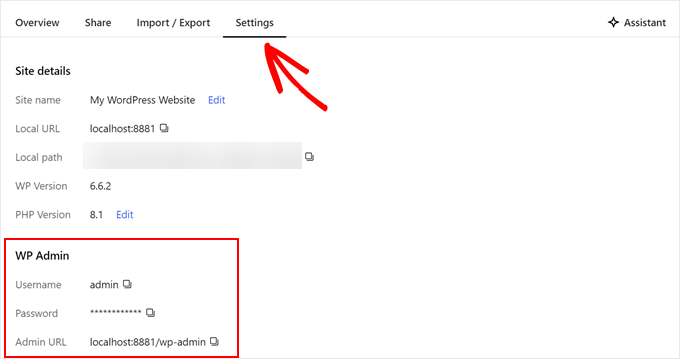
Une autre fonctionnalité intéressante de Studio est son chatbot IA intégré, avec lequel vous pouvez communiquer en cliquant sur le bouton “Assistant”.
Ici, vous pouvez demander de l’aide à Studio pour des tâches telles que la mise à jour de toutes vos extensions en une seule fois, la mise à jour de votre version principale de WordPress ou la création de code pour un bloc personnalisé.

Lorsque vous avez fini de travailler sur votre site local, survolez le bouton “En cours d’exécution” dans le coin supérieur droit jusqu’à ce qu’il indique “Arrêter”.
Cliquez ensuite sur le bouton pour arrêter le site.

L’inconvénient de Studio est que vous ne pouvez pas configurer l’environnement WordPress à votre guise. Cela signifie que vous devez utiliser la version PHP, le serveur web et la base de données qui ont été présélectionnés pour vous.
Cela peut être un inconvénient si vous devez tester votre site ou votre extension avec des configurations de serveur spécifiques.
Si vous avez besoin de plus de contrôle sur votre environnement WordPress local ou de faire correspondre votre configuration locale avec une configuration de serveur live spécifique, alors vous pouvez consulter la méthode suivante en utilisant Local WP.
Méthode 2 : Installer WordPress sur Windows en utilisant Local WP (plus personnalisable)
Tout d’abord, vous devez télécharger et installer le logiciel Local WP sur votre ordinateur Windows. Il vous suffit de vous rendre sur le site de Local WP et de cliquer sur le bouton “Télécharger gratuitement”.
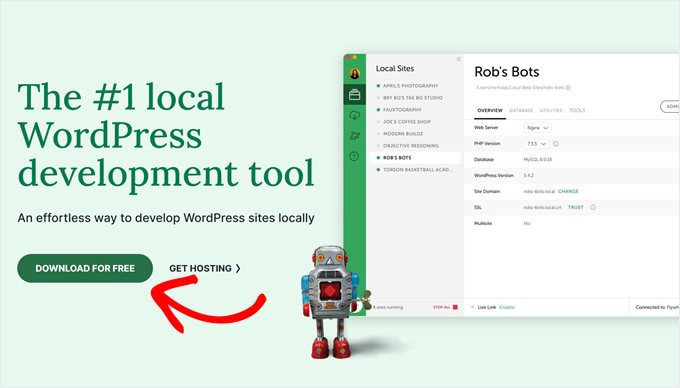
Après cela, une fenêtre popup apparaîtra où vous devrez sélectionner votre plateforme. Choisissez “Windows” dans le menu déroulant.
Ensuite, vous pouvez saisir vos coordonnées telles que vos nom et prénom, votre adresse e-mail professionnelle et votre numéro de téléphone pour télécharger le logiciel.

Après avoir saisi/saisie les détails, il suffit de cliquer sur le bouton “Get it Now”.
Ensuite, le logiciel sera automatiquement téléchargé sur votre ordinateur. Sinon, vous pouvez cliquer sur le lien “cliquez ici” pour lancer le téléchargement.

Une fois le fichier téléchargé, lancez l’assistant de configuration.
Vous devez maintenant sélectionner si vous souhaitez installer le logiciel pour tous les utilisateurs ou seulement pour vous.
Une fois que vous avez sélectionné une option, cliquez sur le bouton “Suivant”.
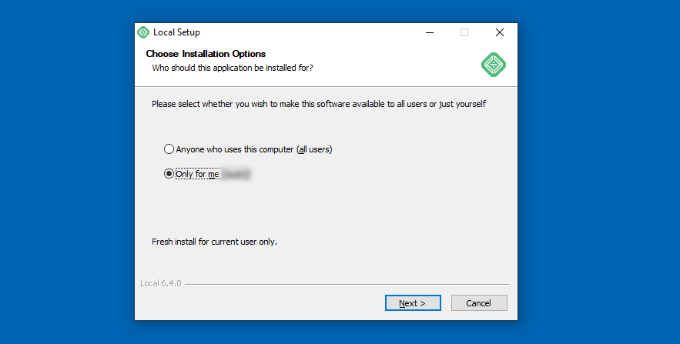
À l’étape suivante, vous pouvez sélectionner le “Dossier de destination” dans lequel le logiciel sera installé.
Il suffit de cliquer sur le bouton “Parcourir” pour définir le chemin d’accès, puis de cliquer sur le bouton “Installer”.
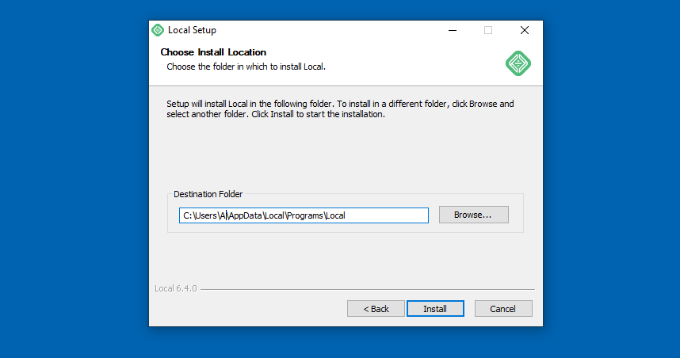
Le logiciel Local WP va maintenant s’installer sur votre ordinateur Windows.
Une fois que c’est fait, vous pouvez cocher la case “Exécuter localement” et cliquer sur le bouton “Terminer” de l’assistant de configuration.
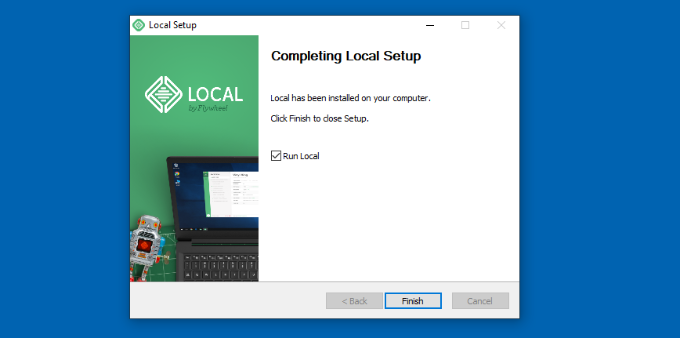
Le logiciel est maintenant lancé sur votre appareil Windows.
L’étape suivante consiste à ajouter un nouveau site local. Pour ce faire, il suffit de cliquer sur le bouton “+” en bas de la page.
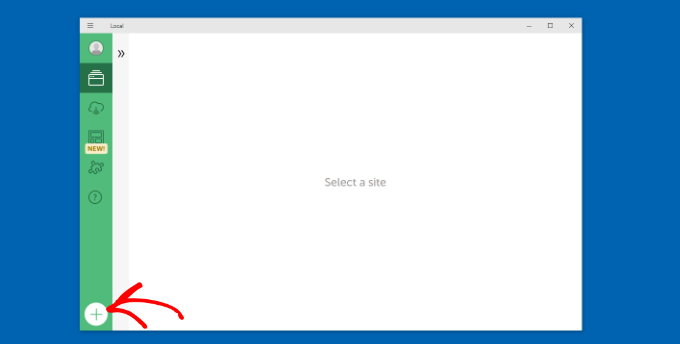
Ensuite, vous pouvez créer un site dans le logiciel local.
Sélectionnez l’option “Créer un nouveau site” et cliquez sur le bouton “Continuer”. Il est également possible de créer le site à partir d’un plan ou d’un fichier de site web existant, mais nous choisirons la première option pour les besoins de la démonstration.

Ensuite, vous pouvez saisir un nom pour votre site local, par exemple “Mon site WordPress”.
Il existe également des options avancées qui vous permettent de saisir le domaine et le chemin d’accès du site local. Par défaut, le domaine utilisera le titre de votre site, mais séparé par des tirets.
Une fois que vous avez terminé, cliquez simplement sur le bouton “Continuer”.

Ensuite, vous devrez choisir un environnement pour votre site local.
Vous pouvez utiliser l’environnement “Préféré” dans lequel le logiciel sélectionnera automatiquement la version PHP, le serveur web et la version MySQL. D’autre part, vous pouvez également sélectionner “Personnalisé” et saisir les détails de l’environnement.
Local WP propose les dernières versions de PHP. En ce qui concerne le serveur web, vous avez le choix entre NGINX et Apache. Vous pouvez également sélectionner MySQL ou MariaDB pour les bases de données.
Notez que certaines versions de PHP, de serveurs web et de bases de données nécessitent le téléchargement de certaines dépendances pour fonctionner correctement.
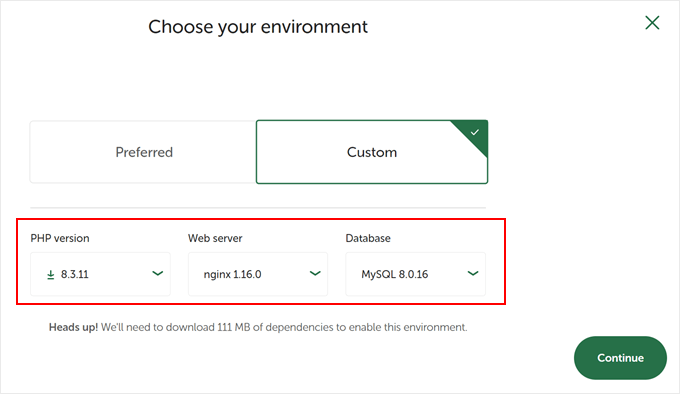
Ensuite, vous pouvez saisir un nom d’utilisateur et un mot de passe WordPress pour votre site local. Il est également possible de choisir une adresse e-mail WordPress à laquelle vous recevrez toutes les notifications par e-mail.
À part cela, il y a une option avancée où le logiciel vous demandera si vous avez un réseau multisite WordPress. Si ce n’est pas le cas, cliquez simplement sur “Non”.
Après avoir saisi/saisie ces informations, il suffit de cliquer sur le bouton “Ajouter un site”.
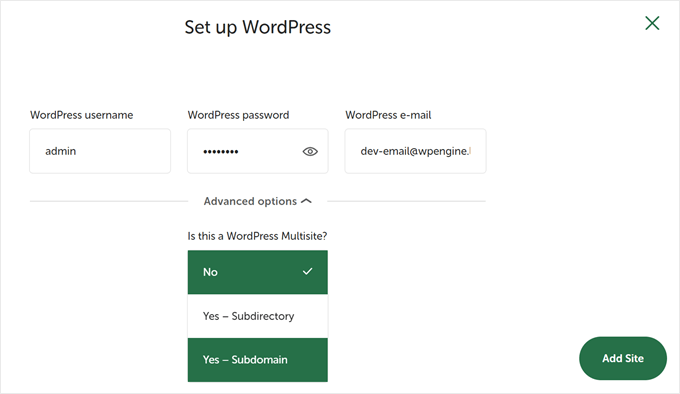
Le logiciel va maintenant installer WordPress et configurer votre site.
Pour lancer le site local, cliquez sur le bouton “Démarrer le site” en haut à droite.
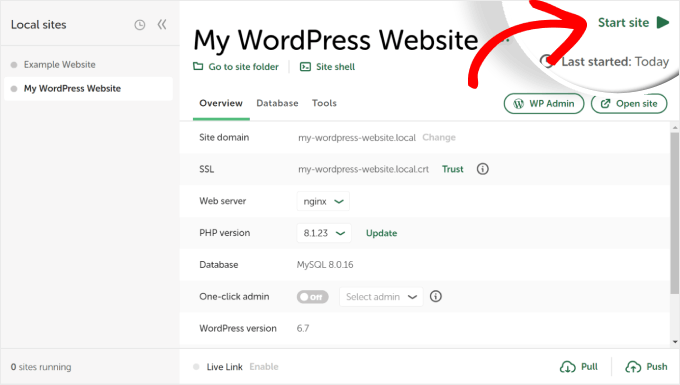
Ensuite, cliquez sur le bouton “WP Admin”, et vous verrez la page de connexion à l’administration de WordPress.
Il suffit de saisir le nom d’utilisateur et le mot de passe que vous avez saisis lors de la configuration du site local, puis de cliquer sur le bouton “Se connecter”.

Vous pouvez maintenant modifier votre site local sur votre ordinateur Windows.
Lorsque vous avez terminé, n’oubliez pas d’arrêter le site à partir du logiciel Local WP en cliquant sur le bouton ‘Arrêter le site’.
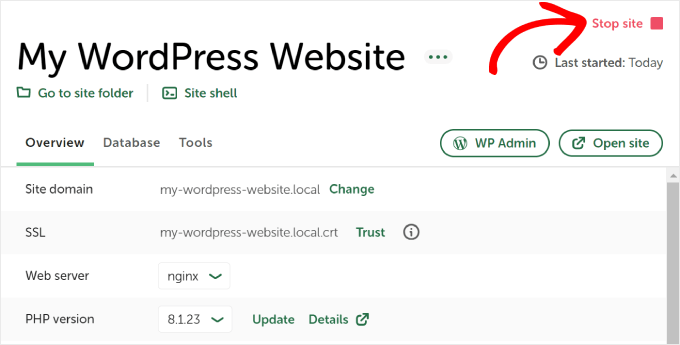
Astuce : Si vous voulez sauter le processus de connexion, vous pouvez activer une connexion d’administration en un clic dans Local WP.
Pour ce faire, il suffit de retourner dans le tableau de bord local de WP et de faire basculer le bouton ” One-click admin ” jusqu’à ce qu’il indique ” On “. Ensuite, dans le menu déroulant, sélectionnez l’utilisateur administrateur qui peut utiliser cette fonctionnalité de connexion en un clic.

Alternative : Utiliser WordPress Playground pour tester des thèmes, des extensions et plus encore
WordPress Playground est un outil innovant qui vous permet d’expérimenter avec WordPress directement dans votre navigateur web. Il s’agit d’un bac à sable virtuel où vous pouvez essayer de nouveaux thèmes, extensions et fonctionnalités WordPress sans affecter un site réel.
Le terrain de jeu WordPress diffère d’un environnement WordPress local à plusieurs égards.
Tout d’abord, il ne nécessite pas d’installation sur votre ordinateur et se réinitialise après chaque utilisation, contrairement aux installations locales permanentes. Vous pouvez y accéder depuis n’importe quel appareil doté d’un navigateur, alors que les installations locales sont liées à un ordinateur.
Alors que WordPress Playground est idéal pour les tests rapides et l’apprentissage, un environnement WordPress local sur votre ordinateur Windows offre plus de flexibilité pour les projets de développement à long terme.
Pour une description détaillée, consultez notre guide sur l ‘utilisation de WordPress Playground dans votre navigateur.
J’ai installé WordPress sur mon ordinateur Windows, que faire maintenant ?
Maintenant que vous avez installé WordPress sur votre ordinateur, voici ce que vous pouvez faire :
- Apprenez les trucs et astuces de base de WordPress pour mieux utiliser votre site.
- Essayez différents thèmes WordPress pour voir à quoi votre site peut ressembler.
- Installez et testez les extensions WordPress indispensables pour ajouter de nouvelles fonctionnalités à votre site.
- Apprenez à corriger les erreurs courantes de WordPress par vous-même.
- Essayez différents constructeurs de pages par glisser-déposer pour rendre votre site attrayant.
- Découvrez comment réinitialiser le mot de passe administrateur de WordPress sur localhost pour récupérer l’accès à votre site.
- Mettezen place des flux de travail automatisés pour faciliter la gestion de votre site.
- Apprenez à connaître la sécurité de WordPress pour protéger votre site des pirates informatiques.
- Déplacez votre site WordPress local vers un serveur live lorsque vous êtes prêt à le partager avec tout le monde.
Nous espérons que cet article vous a aidé à apprendre comment installer WordPress localement sur un ordinateur Windows. Vous pouvez également consulter notre article sur la façon d’installer WordPress localement sur un ordinateur Mac et notre guide ultime pour créer un site de mise en scène WordPress.
Si vous avez aimé cet article, veuillez alors vous abonner à notre chaîne YouTube pour obtenir des tutoriels vidéo sur WordPress. Vous pouvez également nous trouver sur Twitter et Facebook.





Pulkit
Thank you so much for this tutorial, it will surely help me a lot
Dubba Ramesh
Very nice tutorial.
its very use full to me..
thank you very much…..
Pradeep
Thank you very much. I was facing trouble earlier doing it and here detailed yet simple steps lead me to finish it. Great work keep doing it.
alex
hi
i do it like u.
but when i fiill everu thing and wana to go to next page to finish set uo the page is wite and dosnt show any thing !!!
i can see the admin page : 127.0.0.1/wp-login.php but the username and password dosnt work !!
what do i do ??
thx
Yvonne
Need help please….
I’ve downloaded wamp and did some set up (followed other instructions on youtube), it is now “online” but when I tried to access phpMyAdmin, it says “#1045 – access denied for user ‘root’@’localhost’, can anyone give me some advice, please?
Thank you so much!!!
sarvesh maurya
I have install wamp server and my wordpress also works very well,
But,
When i going to install any theme or plugin to my wordpress it doesn’t install properly and showing error message in table form which is not understandable for me…………
solve this problem please…….
it is very important……
REPLY FAST PLEASE….
WPBeginner Support
What error message do you see?
Admin
Skippy McGregor
If you’re having issues with this, run WAMP as an administrator (right click from start menu > run as administrator). The icon in the notification area needs to be green.
John
Thank you, I am using Sitegorund servers, but it was very nice to learn how to work offline!
Marcia
Three years ago, I spent days of my life trying to get WordPress running on my computer. I managed to make it work, but the process was very, very painful.
This time around, I followed your concise, clear and excellent instructions. The result: quick and pain-free success. Thank you !!!
WPBeginner Support
Thanks for the feedback. Glad you found this helpful.
Admin
Wayne
Hi there, Worked great. I did find that I was getting a 404 when trying to view the site localhost/mysite/ but when I tried in Chrome Incognito it worked fine. Also, it appears that the configuration file is now created automatically while using WordPress 4.4.1.
Thanks for the tutorial.
Andrew
I’ve installed wordpress into the www folder, Apache is running but when I try with localhost/worpress/ we get a 404 error, how can we fix this?
Tunde
Thank you very much for this tutorial. It works perfectly.
René Rijlart
Helpfulllllll
Chris
I hate this open source garbage. I can never get it to work. I follow the freaking examples perfectly, and I get all kinds of errors and stuff doesn’t work… WordPress and WAMP is freaking CRAP!!!
Peter
Funny comment … Just followed the instructions, downloaded WordPress, and reached the Dashboard. Everything worked smoothly and quickly — five minutes at most. And I am 80 years old — by rights I should be the one to have been lost …
samar
thanks
it’s helpful
Ryan
Sorry, I need a wp-config-sample.php file to work from. Please re-upload this file to your WordPress installation.
How can I resolve this. I have edited and renamed the wp-config.php file but things cant just work for me. Its been two days now. I cant make progress
WPBeginner Support
Download a fresh copy of WordPress to your computer. Unzip the file and then go to WordPress folder. Inside the folder you will find wp-config-sample.php file. You can now upload this file to your website using an FTP client.
Admin
Chris
Hi guys, I also had an issue with the getting a 404 error and permission error. I misinterpreted the text so in case anyone else has done the same let me paraphrase the following paragraph:
“Download a copy of WordPress from WordPress.org. Extract the zip file and copy the wordpress folder. Go to C:\wamp\www and paste wordpress folder there. You can rename the wordpress folder to anything you want for example mysite, wpbeginner, etc”
1) After installing WAMP, in the windows GUI navigate to ‘C:/wamp/www’
2) The drop the extracted WordPress folder (not just the loose files).
I was doing it wrong; I was dropping the loose files from inside WordPress into the www folder and changing the name. It seems this is incorrect.
Enjoy!!
Chris
I installed WAMPServer, clicked on phpMyAdmin, then in the browser I got:
Server Error in ‘/’ Application.
Access is denied.
Description: An error occurred while accessing the resources required to serve this request. The server may not be configured for access to the requested URL.
Error message 401.2.: Unauthorized: Logon failed due to server configuration. Verify that you have permission to view this directory or page based on the credentials you supplied and the authentication methods enabled on the Web server. Contact the Web server’s administrator for additional assistance.
Version Information: Microsoft .NET Framework Version:4.0.30319; ASP.NET Version:4.0.30319.34274
tomi
Hello
When I run http://localhost/mysite/ I get a 404 error. I have no idea how to fix it and could use some help:)
Screenshoted issue: http://prntscr.com/9ft5z6
Thanks in advance!
WPBeginner Support
Make sure apache is running on your computer. If you are using Wamp or Xamp then you can see apache status in your taskbar.
Admin
Sohail Nawaz
thankyou very much.
Soph Desharnais
Great tutorial. No issues and was set up in less than 10 minutes. Thank you.
Tasneem
Hi
Thank you sooo much for this awesome tut, I also have the followup one bookmarked for moving localhost site to live. I am now all set up with my test site on my local server. No more building websites with a maintenance plugin needed!
My question is, do I have to create a new database and new wordpress site for every new site I build, or can I just clean out and reuse this same test_db and localhost/testsite that I created if I don’t need it anymore? what do you guys do?
WPBeginner Support
It is better to create a new test site for any new project.
Admin
Nadia
Hello, thank you for that great tutorial! It works almost perfectly for me. The only problem I have is that I am not allowed to upload images by grad and drop in the media library. I’ve got javascript error “Uncaught TypeError: Cannot read property ‘appendChild’ of null – load-scripts.php:22”
That said it’s not a problem of the upload itself because I am able to upload images via “Media” > “Add New”.
Is it only my problem? I’ll be really grateful for any assistance with it. Thanks!
WPBeginner Support
Please try deactivating all plugins and then adding an image using drag and drop. If this resolves your issue, then one of the plugins installed on your site is conflicting with WordPress core.
Admin
Nadia
Thank you for the prompt reply! NO plugins at all, fresh wp 4.3.1 installation
Nadia
I resolved this by installing XAMPP instead of Wampserver. I had issues with XAMPP as well, and learned to run it as administrator in my Windows 8. It fixed the issues and maybe there was the similar one with the Wampserver.
Anwar Manha
Hi
I tried the exact step but thrown by the below error, could you please advise
( ! ) Warning: require(C:\wamp\www\test1/wp-includes/load.php): failed to open stream: No such file or directory in C:\wamp\www\test\wp-settings.php on line 21
Call Stack
Daniel
Hi, i have made a website using the WAMP-server.
When try to acess the website from my phone to check the responsivness, all i get is the the text from the website. No styling or pictures are shown.
Is there any type of settings that i have to enable?
John van Rems
Maybe I’m stupid but after installing the Wampserver I try to open phpMyAdmin to setup a database but instate of getting a page like the example the browserpage is empty… Logic I guess because Apage doesn’t run so I can’t see php pages on a local machine.
I try to run it on Windows 10 Can you tell me what’s wrong?
John
John van Rems
Problem solved by correcting te Windows 10 Internetport to 8080
Now to find out how to connect the php db to my wordpress
tsega
hi
Nice post. I find it helpful but i wonder how can i use my own them. Can you give as your expertise on that ?
Keith in Winchester
A full day of headbanging and I was just about to give up when I found this invaluable site. Could not have been made easier. Follow the well laid out instructions and you will find it a breeze. Great work and Many Thanks.
Medha
Thank you so much, this really helped!
John
Hi,
I followed all the instructions up to the point where i go through my web browser to localhost/mysite. I get the error “wp-seetings.php is missing” however the link you provided to create a configuration file is empty. How do i create “wp-settings.php”?
Thanks
Ahsan
Thanks guys, it was surely a great help!
sandeep
thank you so much. very good tutorial.
Mike
This is a real beauty! Thanks so much. I know HTML, CSS, JavaScript, PHP, a very little MySQL — no genius at some of it, but I know what I’m doing. But an organization I’m involved with may wind up using WordPress and I’ve never liked these WYSIWYGs. Since I do want to learn the stuff, though, I wanted to give it a swing on localhost rather than messing up my own GoDaddy- and Netfirms-hosted domains.
Just follow your directions and this installs beautifully. One question, though. Is there any particular book you’d recommend? I was particularly looking at the Dummies All-in-One and the Missing Manuals books. Is one better than the other? Or do you recommend a third alternative? I don’t want to buy a whole library full of this stuff for a technology I may never use that much except for helping this organization with upkeep.
WPBeginner Support
Check out WordPress Books section on our website.
Admin
Liana
after I click on the phpadmin all I get is a blank page with nothing on it :/
raydy
Hi There, Thanks for the tutorial
however, i encounter with this problem for localhost/mysite/
Not Found
The requested URL /mysite/ was not found on this server.
Apache/2.4.9 (Win32) PHP/5.5.12 Server at localhost Port 80
Alok
Hi,
I am also facing the same problem…Did you get the solution? Can you please help.
Regards,
Alok
Mike
Thumbs up mate,
Great guide…it was very helpful!
Julian
Please help. This is what I get:
“Not Found
The requested URL /mysite/ was not found on this server.
Apache/2.4.9 (Win64) PHP/5.5.12 Server at localhost Port 80”
I took my wordpress folder and dropped it in the wamp folder, C:\wamp\www. I renamed my wordpress folder to: “mysite”. I then went to Chrome and searched: “localhost/mysite/”. And I get:
“Not Found
The requested URL /mysite/ was not found on this server.
Apache/2.4.9 (Win64) PHP/5.5.12 Server at localhost Port 80.”
Kyle
Burnt out. Seriously. Help.
No manner of step by step instruction is working and I’m pulling out my hair. What am I missing?
“Download a copy of WordPress from WordPress.org. Extract the zip file and copy the wordpress folder. Go to C:\wamp\www and paste wordpress folder there. You can rename the wordpress folder to anything you want for example mysite, wpbeginner, etc. For the sake of this tutorial, we renamed our wordpress directory to mysite. Now open a web browser and go to:
http://localhost/mysite/”
C:\wamp\www ???
First off, there is no folder titled “www,” so maybe you’re implying the website name take that place? I don’t really know.
Still, I tested all methods. I tried creating a folder called ‘www,’ I tried simply C:\mamp\sitename, But when I type in the “localhost/sitename” absolutely nothing happens.
I have experience doing website redesigns and all I want to do is clone this site to my local host and I am baffled at how I’ve spent 2 whole days just trying to get WordPress isn’t even installed on my local host.
Thank you in advance.
Composed under duress.
Captain
Hello Kyle, sorry for your sad experience.
You said you don’t see a folder called “www” on C:\wamp.
Can you check to confirm that you have wampserver installed on your computer?
Also, it could be it’s installed but not on the C drive.
Do get back when you confirm; cos the tutorial was quite straight and worked really well for me.
aman
After installing WAMP server and clicking on phpmyadmin there is an error that says Access Denied and no other option is displayed. Please Help me
DutchLuck
Great tutorial, sweet and simple!!! Thanks!!!
Karthikeyan
Good Example.Its working fine for me.
Thank you all..
Janvi
hi
i m not getting create configuration file option
WPBeginner Support
Your WordPress folder may already have a wp-config.php file. This file may not have correct information for your WordPress database settings. Please see our guide on editing wp-config.php file in WordPress.
Admin
Samantha T
Sooooooooooooooooooooo… I uninstalled everything and reinstalled. Now I have an orange light on the Wamp, and when I open phpMyAdmin, I get “Access denied”: MySQL said: Documentation
#1045 – Access denied for user ‘root’@’localhost’ (using password: NO)
phpMyAdmin tried to connect to the MySQL server, and the server rejected the connection. You should check the host, username and password in your configuration and make sure that they correspond to the information given by the administrator of the MySQL server.
*sigh*
Joe
OK, how do you do that?
odion
After installation of wordpress in my computer, I did not receive a success message but a blank white page and am not able to login into the wp-admin.
odion ikhidero
Pls I got. The following errors after installation
Sansun
I already have MySQL server running in my local 3306 port, how do I install WAMP in my case?
Aamir
Thanks for the help.
I have been taking help from your immensely helpful site. It is a great service that you guys are providing.
Jim14409
Hi, )
)
Thanks for your site and all the help you offer. I installed WAMP and everything went perfectly until I reached the part where you said:
“WordPress will inform you that it can not find a wp-config.php file.”
Well WP never said that :0 but sent me directly to a Directory of “JimSite” with links there to Parent Directory and a link to WordPress. Finally clicked the WordPress link and now it seems we are heading to the config-php setup. (I’ll holler back if the trail dead-ends
Thought you might want to amend your guide with a note about this possibility for some users so as to save them the confusion and frustration I’ve had the past half hour. Might have something to do with my using Vista64, I’m not sure.
Thanks again and for your nice email when I signed up.
Jim
Markus
Thanks for this nice tutorial. Its really helpful, and works like a charme to set up.
The skype addition about the port issue with wamp helped me also – sometimes wamp just wouldn’t work and I didn’t know why. (I’m using skype just once in a while..)
I’ve got another question though: How to move a live website to localhost for development.
I’m not really sure how to go about it. Copy everything (including db) and change the settings in the config file of wordpress. or install wordpress and then migrate the database somehow, and add the other special content…
WPBeginner Support
See how to move a live WordPress site to local server.
Admin
Samuel
Thanks
But I have an issue. After installation, I got a prompt “The program can’t start because MSVCR110.dll is missing from your computer, Try reinstalling the program to fix the problem”
What do I do?
Dev Enthusiast
Hi Samuel,
The error that you received can be fixed by downloading and installing the following from Microsoft:
Visual C++ Redistributable
Give that a try!